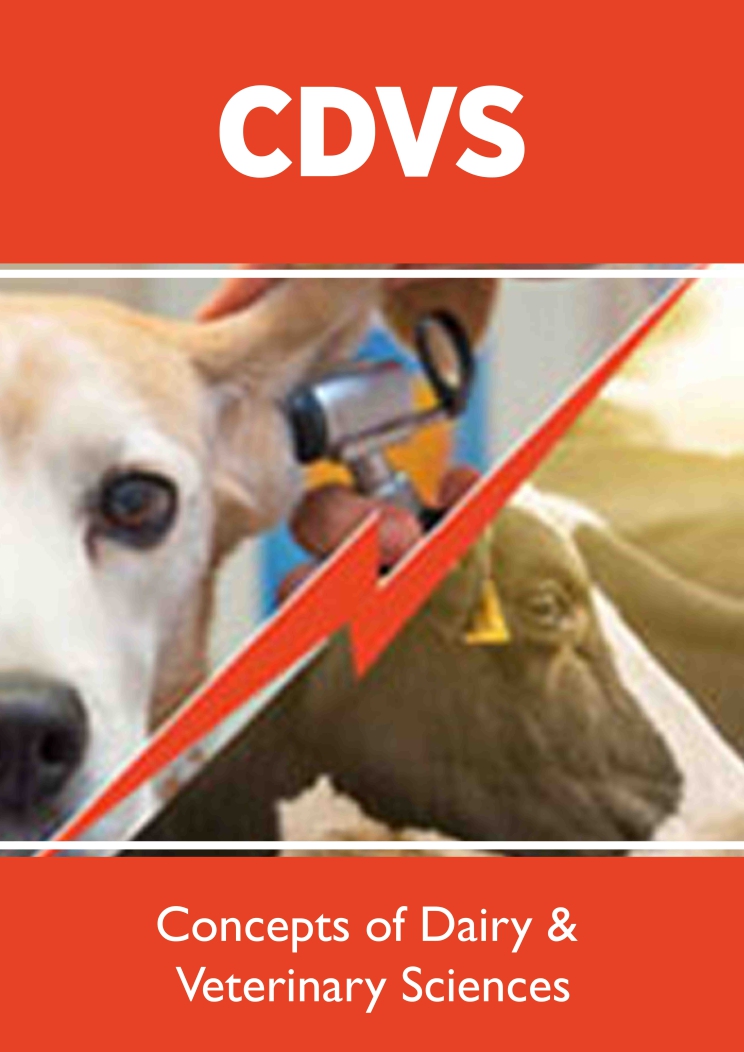
Lupine Publishers Group
Lupine Publishers
Menu
ISSN: 2637-4749
Short Communication(ISSN: 2637-4749) 
Impact of Fresh Grass Diet and Processing Temperature on The Variability of Azorean Bovine Milk Conjugated Linoleic Acid Content Volume 5 - Issue 5
Lisete Paiva1,2 and José Baptista1,2*
- 1Department of Physics, Chemistry and Engineering (DCFQE), Faculty of Science and Technology, University of Azores, Portugal
- 2Institute of Aricultural and Environmental Research and Technology (IITAA), University of Azores, Portugal
Received: June 21, 2024; Published: June 24, 2024
Corresponding author: José Baptista, Department of Physics, Chemistry and Engineering (DCFQE), Faculty of Science and Technology, Institute of Agricultural and Environmental Research and Technology (IITAA), University of Azores, Portugal
DOI: 10.32474/CDVS.2024.05.000222
Abstract
Conjugated linoleic acid (CLA), found naturally in ruminant meats and predominantly in bovine dairy products, refers to a series of conjugated dienic positional and geometric isomers of octadecadienoic acid (linoleic acid). Dairy products are the major dietary sources of CLA, which cis-9, trans-11-CLA, and trans-10, cis-12-CLA are the major isomers plus minor amounts of a wide number of other isomers present. The cis-9, trans-11-CLA isomer, produced in rumen by partial ruminal biohydrogenation of linoleic acid by the anaerobic bacteria Butyrivibrio fibrisolvens as an intermediate step of unsaturated fatty acids (via linoleic acid isomerase) or by endogenous synthesis in body tissues (mammary tissue and adipose) catalyzed by Δ9-desaturase enzyme being trans-11-C18:1 (trans vaccenic acid) the precursor, is affected by several factors, such as: animal’s breed, different diets, management factors, stage of maturity, seasonal variation, and preservation conditions of forages.
The cis-9, trans-11-CLA is the predominant isomer because there appear to be two routes of formation representing ca the 80% of total CLA in milk. The aim of this study was to compare the CLA content in Azorean cows’ milk with two different types of diet: cows grazing pasture (fresh grass) during all seasons and cows fed mainly with mixed ration feeding for one year period, and to investigate the effect of the processing temperatures (pasteurization and ultra pasteurization) as compare with raw milk, on the cis-9, trans-11-CLA isomer content. The relative average of cis-9, trans-11-CLA isomer content in Azorean milk represents 1.33±0.08% and 0.77±0.07% of total fatty acid methyl esters (tFAME), respectively, for two different types of diets, that ranged from 1.16±0.08% to 1.57±0.09% for one year period. The effect of the temperature on the cis-9, trans-11-CLA isomer decrease 12.1% and 21.7% (% of tFAME) during pasteurization and ultra pasteurization of raw milk processing.
Results
The biological properties of CLA are attracting the scientific community, because of its wide range of health benefits, particularly anti-carcinogenic, anti-atherosclerosis, and anti-obesity [1], anti-diabetic [2] and enhancement of immunity properties [3], demonstrated “in vivo” studies using different animal models. High quality raw milk, from Azorean lactating Holstein cows (the same breed) grazing pasture (fresh grass) during all seasons, donated by Unlimited Milk Plant, were collected in sterilized flasks, refrigerated at 4 °C and after fat adjustment (1.5% - half-skymmed) were stored at -20 °C. The commercial pasteurized and ultra pasteurized (UHT) half-skymmed (the most consumed in the Azores Islands) samples, obtained from local stores, were taken in triplicate from cows of different ages, in several lactating phases, and obtained from different farms at different times of the day, were used as milk samples from cows fed with mixed ration feeding. The fatty acids (FA) and CLA from different type of milk samples were determined following the methodology described by Jiang et al. [4] with some modifications to minimize oxidation and formation of artifacts during the extraction, and to achieve more complete hydrolysis of milk fat phospholipids and triacylglycerols.
Extraction
A 15 mL milk sample, transferred into a separatory funnel, was added 25 mL of isopropanol. After vigorous shaking, 20 mL of hexane was added, and the mixture was shaken again for 3 min using vortex. The mixture was then centrifuged at 2.500 rpm for 10 min at 5 °C, and the upper layer (hexane plus fat) was quantitatively transferred to a second separatory funnel. The lower layer was extracted twice, in the same conditions, with 10 mL of hexane, and the supernatant was added to the previous hexane layer. After addition of 10 mL of 0.5 M aqueous Na2SO4, the hexane layer (upper layer) was collected into a centrifuge tube and kept at -20 °C for 20 min. After reaching the room temperature, the material was centrifuged at 2.500 rpm for 5 min at 5 °C, quantitatively transferred to a flask and evaporated at 37 °C. The residue was dissolved in dichloromethane (5 mL) and dried with anhydrous sodium sulfate in order to remove traces of water. Finally, the sample was dried in a rotatory evaporator to constant weight and the gravimetric determination of the fat was performed using a microbalance.
Hydrolysis, derivatization and analytical determination
Prior to gas chromatography (GC) analysis, the FA must be converted to derivatives, mostly methyl esters, but some of the methods are unsuitable for use with conjugate free FA. Esterification of free CLA can be achieved, but some of the methods lead to isomerization and have shown artifact formation on the reaction with CLA. The total fatty acid methyl esters (tFAME) of the extracted fat were analyzed on a Bruker model 450 GC fitted with a flame ionization detector, using an autoinjector CP-8410. The instrument was fitted with a split/spitless injector and a capillary column -CP-Sil 88 (0.2 mm i.e. x 100 m in length), with 0.2 μm film thickness. The column temperature was held at 60 °C for 2 min, programmed at a rate of 20 °C /min to 175 °C and held for 50 mim. The temperature was again increased to 220 °C at a rate of 4 °C and held for an additional 30 min. Helium was the carrier gas at a flow rate of 1.60 mL/min and pressure programming (inlet pressure) was used in constant flow mode at 180 KPa. The injector and detector temperatures were held constants at 250 and 300 °C, respectively. The percentage of each fatty acid, after correction with detector response factor for each individual FAME, was calculated by dividing the area under the fatty acid peak by the sum of the areas under the total reported fatty acid peaks (Figure 1,2,3).
Figure 1: The variability of the cis-9, trans-11-CLA isomer raw milk content throughout the year of 2023.

Figure 2: Comparison of cis-9, trans-11-CLA isomer content of milk with different types of diet: A-Cows grazing pasture (fresh grass) during all season; B-Cows fed mainly with mixed ration feeding for one year period.

Figure 3: Effect of processing temperatures (pasteurization and ultra pasteurization) on cis-9, trans-11-CLA isomer (% of tFAME).

Conclusion
The composition of milk fat and CLA contents, particularly the cis-9, trans-11-CLA isomer of Azorean raw, pasteurized and UHT milk samples change throughout the year showing higher profile values in summer and lower profile values in winter and beginning of spring seasons. The cis-9, trans-11-CLA isomer content of Azorean milk fat present different values in milk from cows with different diets. Higher content of CLA is found in milk fat from cows grazing pasture (fresh grass), as compared with that from cows fed mainly with mixed ration feeding during one-year period.
The cis-9, trans-11-CLA value decrease with processing temperature showing higher values in raw milk as compared with pasteurized and ultra pasteurized sample milks; The Azorean milk CLA have a relatively little variation throughout the year, that reflects the mild climate in Azores Islands all year around.
References
- Laura J den Hartigh (2019) Conjugated Linoleic Acid effects on cancer, obesity, and atherosclerosis: A Review of pre-clinical and human trials with current perspectives. Nutrients, 11(2): 370.
- Song K, Song IB, Gu HJ, Na JY, Kim S, et al., (2016) Anti-diabetic Effect of Fermented Milk Containing Conjugated Linoleic Acid on Type II Diabetes Mellitus. Korean J Food Sci Anim Resour 36(2): 170-177.
- Rastgoo S, Shimi G, Shiraseb F, Karbasi A, Ashtary-Larky D, Yousefi M, Golalipour E, Asbaghi O, Zamani M (2023) The effects of conjugated linoleic acid supplementation on inflammatory cytokines and adipokines in adults: A GRADE-assessed systematic review and dose-response meta-analysis. Front Immunol 14: 1092077.
- Jiang J, Bjoerck JR, Fondén R, Emanuelson M (1996) Occurrence of Conjugated cis9, trans-11-Octadecadienoic Acid in Bovine Milk: Effects of Feed and Dietary Regimen. J. Dairy Sci 79(3): 438-445.

Top Editors
-

Mark E Smith
Bio chemistry
University of Texas Medical Branch, USA -

Lawrence A Presley
Department of Criminal Justice
Liberty University, USA -

Thomas W Miller
Department of Psychiatry
University of Kentucky, USA -

Gjumrakch Aliev
Department of Medicine
Gally International Biomedical Research & Consulting LLC, USA -

Christopher Bryant
Department of Urbanisation and Agricultural
Montreal university, USA -

Robert William Frare
Oral & Maxillofacial Pathology
New York University, USA -

Rudolph Modesto Navari
Gastroenterology and Hepatology
University of Alabama, UK -

Andrew Hague
Department of Medicine
Universities of Bradford, UK -

George Gregory Buttigieg
Maltese College of Obstetrics and Gynaecology, Europe -

Chen-Hsiung Yeh
Oncology
Circulogene Theranostics, England -
.png)
Emilio Bucio-Carrillo
Radiation Chemistry
National University of Mexico, USA -
.jpg)
Casey J Grenier
Analytical Chemistry
Wentworth Institute of Technology, USA -
Hany Atalah
Minimally Invasive Surgery
Mercer University school of Medicine, USA -

Abu-Hussein Muhamad
Pediatric Dentistry
University of Athens , Greece

The annual scholar awards from Lupine Publishers honor a selected number Read More...




